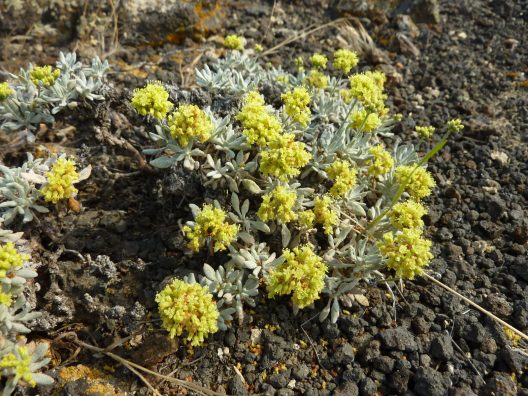Rare Care Plant Profile

An endemic plant found only in Benton County of Washington State, Umtanum desert buckwheat (Eriogonum codium) is a long-lived perennial adapted to grow in an arid landscape. This compact, tufted plant forms a low-branching woody stem from a stout taproot and spreads 2-9 dm laterally but rarely reaching a height much higher than 8 inches. Leaves are basal, oblanceolate to elliptic in shape, and only 6-12 mm long x 3-6 mm wide. They are covered with dense, white-woolly hairs on both surfaces, an adaptation to conserve water and protect against insect damage and ultraviolet light.
Umtanum desert buckwheat blooms May through August, with peak bloom occurring in early July when few other plants are in flower. Flowers cluster in terminal divided inflorescences 2 cm high and 4 cm across borne on leafless stems covered by dense, rigid short hairs. Flowers are lemon-yellow with greenish midribs and covered by dense short hairs.
This species is not adapted to fire, and this may be a factor in its restricted distribution to exposed outcroppings. It grows in one of the driest locations in Washington State on a rocky ridge just above the Columbia River located on the Department of Energy’s Hanford Site. Therefore, the site is closed to the public and carefully controlled by DOE. Unfortunately, this does not protect this species from the long arm of human impact.
The near-by vegetation has significant cover of non-native species due to a history of disturbances related to cultivation, grazing and fire. This encroachment of non-native species into the buckwheat’s habitat exposes the buckwheat to more intense and more frequent fire. The most recent fire in 2017 killed approximately 40% the population. As of 2023 only 2,354 plants remain, down from 5,169 plants in 2011.
Climate change also poses a threat to this species due to direct and indirect effects. Reduced moisture availability and higher temperatures resulting from climate change may impact this species’ ability to establish and persist at the native site and its capacity to disperse. Therefore, establishing new populations may be the most important step that can be taken to prevent extinction of this species.